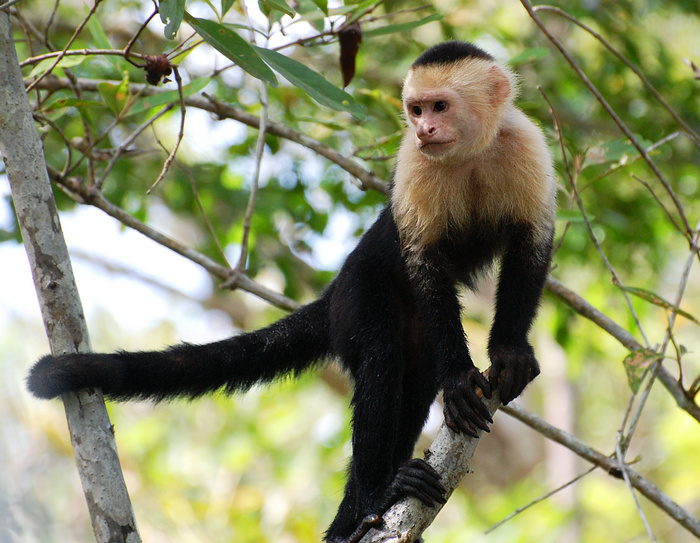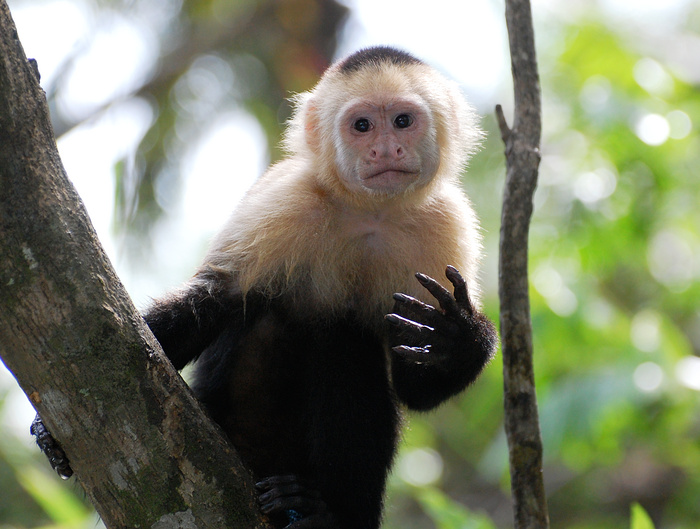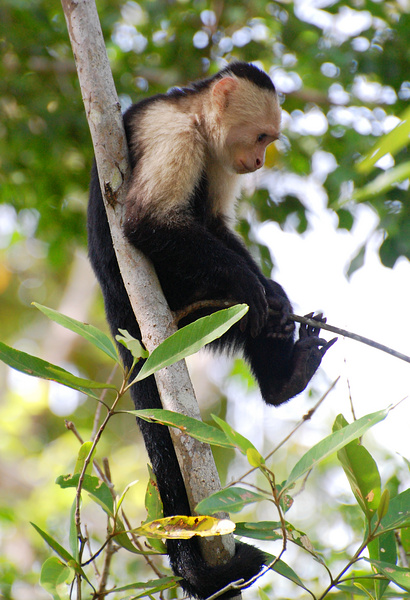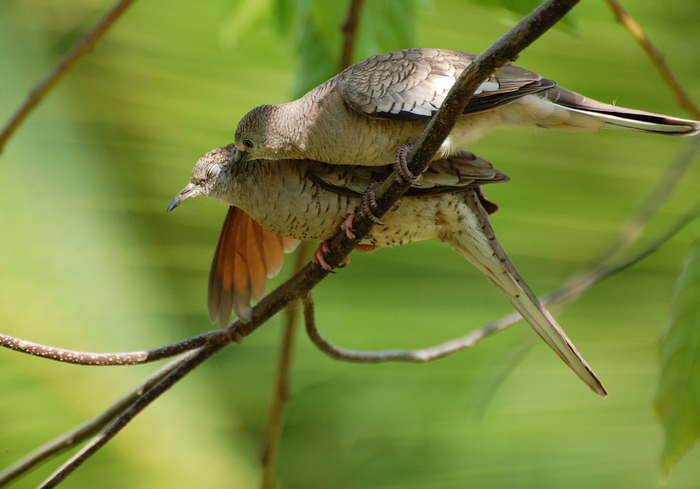
Wherein Ursula Vernon makes me laugh hysterically
April 17th, 2014
Birder Directions: A Play In One Act
El Rey wetlands with Johan Chaves
April 16th, 2014
In the dry season, El Rey was shallow marsh, productive of wading birds like gallinules and herons, plus the occasional kingfisher. (In the wet season the adjacent fields flood and breeding waterfowl move in.) One of the high points for me was a tiny American Pygmy Kingfisher. This guy is less than half the size of the kingfisher we're familiar with in North America (Belted), and eats very small fish and aquatic insects.

Familiar Green Herons were everywhere in Costa Rica, anywhere they could find the tiniest bit of water to fish in. This time of year the resident Green Herons were joined by wintering birds from North America. Like so many of the wintering birds, they seemed tamer than back home.

1680x1050 wallpaper
The beautiful adult Purple Gallinules eluded my camera. I saw them only in brief glimpses. But this juvenile was a lot more willing to come out in the open--perhaps because his camouflage was better! Typical of his species, he stayed expertly out of the water by scrambling over aquatic plants.

As did the jacanas. You can see below the ultra-long toes that allow jacanas to even balance on floating lily pads.

Naranjito and Esquipulas with Johan Chaves (part 2)
April 13th, 2014
A familiar face:

1680x1050 wallpaper
This deep-golden beauty is a Prothonotary Warbler, a North American bird, wintering in the tropics as most warblers do. Prothonotaries are abundant breeders at Dutch Gap, one of my favorite birding spots when I visit my folks in Virginia. They nest in tree holes (or manmade nest boxes) in wetland habitat. I found this one to be especially tame. In fact I find a lot of Costa Rican birds especially tame, as if they know they are in a peaceful country!

There are over two hundred types of tanagers in the Americas, nearly all of whom are restricted to the tropics--probably something to do with their love of fruit. Like our own Scarlet Tanagers (a species I'm still trying to get one good photo of to this day), most of them seem to be deep woods birds who stay well up in the trees and shun open spaces, which is unfortunate given their often stunning beauty. Cherrie's Tanagers were a pleasant exception to the rule. I saw them frequently both during our tours and around the resort.

Common Tody-Flycatcher
The striking pale eye on a dark face is distinctive, making this one of the few easily identified flycatchers.

Green Honeycreeper
If you've been following along closely, the above bird might look familiar to you. I photographed one in better detail at the Biodome a few years ago. Since this was my first wild sighting, it was a lifer. There are three types of honeycreepers in Costa Rica, all of whom specialize in drinking nectar.

Variegated Squirrel
These squirrels vary widely in color and pattern, thus the name. I found this one particularly handsome.
Naranjito and Esquipulas with Johan Chaves (part 1)
April 10th, 2014
Thursday was our first tour with Johan: a forested area called Esquipulas in the morning, then El Rey wetlands in the afternoon. In early morning, we made a stop in a suburban part of Naranjito that Johan knew to be good for birds. There we soon hit paydirt with a gorgeous Fiery-Billed Aracari!

This is the smaller and more vividly colored of Pacific Costa Rica's two species of toucans. It's also the only one that ever came close enough for good pictures. Amusingly, according to him, the locals at Naranjito assume that Johan is a real estate agent. They can't figure any other reason why he would be taking people around their neighborhood and pointing at things.

"I remember my clients by what their favorite bird was," Johan said. "When I think of you, I'll think of Masked Tityra." I liked the tityras mainly because of the weird, buzzy sound they made. They're colloquially known as "pig birds" because it sounds like they're going "oink oink."

A Chestnut-Backed Antbird: one of a large family of tropical birds who follow army ant swarms. As thousands of ants rampage through the forest floor, insects and other small critters leave cover to flee in a panic. Antbirds then swoop down and pick off whatever the ants miss. Some antbirds make their entire living this way; the Chestnut-Backed is more of a casual opportunist. I was on my own when I first found and identified the species, as one crept through the underbrush alongside an Orange-Billed Sparrow (also a lifer.) Johan got this one to stop creeping and come out for a glamour shot by playing back a recording of its call.

Violet-Headed Hummingbird. She was nesting just a few feet over a small stream.
(Continued in next post)
Close Enough To An Elephant
April 7th, 2014
You might be alarmed to see this little egret so close to a huge (and active) tractor. But not only is he not in any danger, the tractor is the whole reason he's there.


These are Cattle Egrets. They're found in North America too, though I've nowhere seen them so abundant as in Costa Rica. If you've ever watched an African nature documentary and seen a bunch of delicate-looking white birds picking around amidst elephants or wildebeests, nimbly evading their crushing footsteps--or even hitching a ride on their backs--these are they. Cattle Egrets evolved to follow large grazing mammals and scoop up the insects disturbed by their foraging. Originating in the old world, they naturally colonized the Americas in the 20th century, learning to forage alongside domestic cattle.
In this case, the egrets decided that a tractor was close enough in effect to "large grazing mammal"! Nearly every day I could find a flock of them following behind it.

In addition to stirring up food, it also liberated some bits of nesting material for them.

Perched in the resort's backyard. It wasn't unusual to find them there.
High Alert
April 5th, 2014
An estuary ran alongside our resort. At low tide you could walk out on the mud and explore. I saw various types of herons and shorebirds there, many of them familiar to me from my vacations to the Outer Banks. But an exciting new bird was Northern Jacana. This handsome, extraordinarily long-toed wader was very common; I could always find at least one of them foraging by the dock at any time of day. They were skittish though. I had to approach slowly and quietly to win their trust (and failed to win it more often than not.)

One of my best photo ops occurred one day when a grackle across the estuary made a piercing alarm call--the kind of alarm call that means "raptor!" The nearby jacana immediately stood up as high as he could and looked in all directions. The possible flying danger was a bigger concern than little ol' me, so I was able to approach closely.

1680x1050 wallpaper

1680x1050 wallpaper

Photo by Michael Britton
The estuary at low(-ish) tide. You can actually see a jacana in this picture too if you look realllly carefully!
Boating the Mangroves (part 2)
April 2nd, 2014
A few more pictures from the boat tour.


This Groove-Billed Ani, believe it or not, was photographed from a brief glimpse in a moving boat. (He looks like he was posing just so, and how I ended up with those background colors in an environment that was mainly mud and mangroves, I have no idea!) Anis, beloved of crossword constructors everywhere (they're usually clued as "black birds"), are a type of cuckoo. They nest communally and are typically seen in groups. No one seems to know why these primarily insectivorous birds have such large and unusual bills.

My first Green Kingfisher. A very common inhabitant of the mangrove swamps.
Boating the Mangroves (part 1)
March 31st, 2014
On Monday we went for a boat tour in the mangroves. The star attraction, of course, was the White-Faced Capuchin monkeys. This bold and intelligent species is numerous in Costa Rica and, because of its fearless nature, easily coaxed into close contact with people. A similar tour was the high point of my honeymoon fifteen years ago. I loved watching the monkeys come right into the boat, interact with us and mooch bananas. But I'm a different person now than I was then. This time around, I found I was turned off by the circus-animal approach to things. These creatures have a fascinating world of their own. Their world matters, with or without humans in it.
So I preferred to photograph the monkeys who were at a distance from us, engaging in more natural behaviors. Of course having a telephoto lens makes that a lot easier!

1680x1050 wallpaper

1680x1050 wallpaper
This guy was flycatching. I never knew monkeys did that.


Two Fearless Garden Birds
March 28th, 2014
Wild hummingbirds are a blink-and-you-miss-it kind of thing. Not infrequently I would find one feeding at a flower bush, only to have it warp into another dimension before I could even get my binoculars up. I saw ten different types of hummingbirds on this vacation but most of them were sadly unphotographable.
The Rufous-Tailed Hummingbirds in the garden, though, were bold and numerous. This one flew to a tree with mimosa-like pink flowers in the front yard one afternoon, and proceeded to feed at every single flower it could find. It stopped at one particularly nectar-laden flower long enough for one good shot.

1680x1050 wallpaper
You usually think of wrens as shy birds, but the Rufous-Naped Wrens at Pueblo Real almost out-bolded the grackles. A pair nested in the fruit tree right in front of our window, and regular came to our balcony to sing. They even looked into our suite curiously. Their song was a mellow, cheery warble, a welcome change from their more strident neighbors.
This is one of the places where our field guide (Garrigues & Dean, which I strongly recommend) was out of date. It shows RNWs as occurring no further south than Carara. Quepos is now very much in their range.

At our balcony planter:

Billing And Cooing
March 25th, 2014
There are many types of doves and pigeons in Costa Rica, but the sweet, tame Inca Doves were my favorite. These little doves range from Central America into the American southwest. They look plain usually, but reveal striking rufous wing patches in flight. This one's rufous is showing a bit after preening itself.

1680x1050 wallpaper
One pair was so trusting, they started to bill and coo right in front of me. The shade of a palm tree provided the perfect lighting.

1680x1050 wallpaper

1680x1050 wallpaper
"Yes, we're ready for our couples shot now."
|
